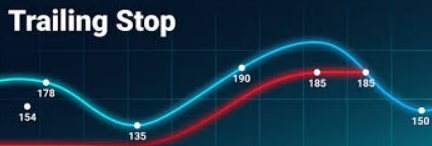
Haiden Holmes
Jun 01, 2022 15:02

Market analysts have long recognized increasing volatility as a precursor to market crashes. If you examine a chart of September and October 1929, just prior to the crash that ushered in the Great Depression, you will observe the same frantic swings of joy and dread that have characterized the US stock market in recent months.
The amplitude of the swings is growing, but the time between each up or down movement is decreasing as well. Consider a succession of windstorms that become progressively violent as the time between them decreases.
This broadening range traces a megaphone pattern on stock charts. The S&P 500 (SPX) has followed a classic megaphone pattern in recent months.
In his 1932 book "Technical Analysis and Stock Market Profits," Richard Schabacker was the first to describe the Megaphone pattern. The Megaphone pattern is a price action trading pattern that forms as a result of rising price volatility, and it is composed of two trend lines that diverge in different directions.
A sequence of higher highs and lower lows that serve as pivot points are present in this pattern. It occurs at the market's peak or trough. The creation of this pattern over a longer period of time makes it more efficient and effective.

A megaphone pattern consists of several candlesticks arranged in a large, sloping megaphone pattern. This pattern can be either bullish or bearish, depending on whether it is sloping up or down. The megaphone pattern can explode upwards or downwards from the structure at any time, although often after the bottom or top trend lines have been tested from 5 to 8 times.
According to an old adage, the stock market is a war between buyers and sellers. The tug of war between bulls and bears produces chart patterns resembling the megaphone, and this is the staple diet of traders.
Due to its creation, megaphone patterns are also known as the broadening formation. During moments of high volatility, stocks may exhibit significant movement without appearing to indicate a clear direction.
Hence the development of a megaphone. It simultaneously makes higher highs and lower lows. Typically, when a stock chooses a direction, it will only move in one direction. When discussing a bullish trend, it is common practice to speak about higher highs and higher lows.
Or when describing a bearish trend, lower lows, and lower highs.
With a megaphone pattern, you receive both higher highs and lower lows! There is a lack of a discernible trend (except within the megaphone). Trend lines are a vital component of this pattern, and they must be drawn with care. Connect your peaks and valleys on both sides with care in order to locate price action.
The megaphone pattern has other names among investors, including:
Depending on the preceding trend, megaphone formations may be bullish or bearish. If the stock is undergoing a bullish (upward) trend at the onset of the megaphone pattern, it is referred to as a megaphone bottom. It is a megaphone top of the stock that is undergoing a bearish (downward) trend at the beginning.
The megaphone pattern and its direction can indicate the stock's future direction. A megaphone bottom pattern can indicate a stock's impending bullish movement. A megaphone top pattern can indicate a stock's upcoming bearish movement.

The megaphone pattern is an illustration of bears and bulls battling for the direction of a stock. The pattern typically occurs when the stock market is volatile, and the direction of a stock is uncertain.
Several characteristics of the Megaphone trading pattern are listed below:
The volume plays a significant influence in the detection of this pattern.
In the Megaphone Top, volume and prices typically peak simultaneously.
On the day of pattern confirmation, an increase in volume is a strong indicator.
When the pattern is formed, it indicates that bulls and bears are competing for stock control.
The pattern occurs when bulls drive the prices higher.
During the construction of the Megaphone Top, bears caused prices to decline, resulting in the formation of lower lows.
Nonetheless, the bears finally prevail.
The target price refers to the possible price movement indicated by this pattern.
Consider whether the goal price for this pattern is sufficient to provide a satisfactory return after your expenses (such as commissions) have been deducted.
A good rule of thumb is that the goal price should exceed 5 percent, but you should consider the current price if the trade is trending in your favor.
A succession of swing highs and swing lows comprise the Megaphone pattern. However, to make such a pattern, there must be at least two swing highs and two swing lows. Thus, two trend lines are formed, the first connecting points being 1 and 3 and the second connecting points being 2 and 4.

You can see that the two trend lines separate from one another. The resulting pattern resembles a megaphone and is also known as a broadening formation pattern or an inverted symmetric triangle. The current swing high or swing low must close higher or lower than its predecessor. Thus, pivot swing highs (R1, R2, R3, etc.) and pivot swing lows are produced (S1, S2, S3, and so on).
A breakout happens when the price breaks through a trend line's resistance or support and closes outside of it after establishing a new swing high or low.
Did you know that megaphone formation is considered bearish? You may question why it is bearish if it is essentially an inverted symmetrical triangle. Triangles with symmetry are neutral.
The broadening formation is bearish if you are a long-term or trend trader, and there is a great deal of volatility without any discernible trend. However, this is excellent news for both day traders and swing traders.
The essence of day trading and swing trading is capitalizing on volatility. In contrast, long-term investors and trend traders like to trade in one direction. Our day trading course is full of helpful tactics for trading numerous patterns successfully, including the megaphone pattern.
You should purchase along the trend lines as this is a volatile pattern. It is advisable to go long when angular support is reached, depending on your style, and go short when angular resistance is encountered. Be ready to cover since megaphones might break out to the upside, escaping the price structure (trend lines).
Trend lines play a critical role in technical analysis. Day and swing traders might therefore profit from the volatility of a broadening formation. Profitable short-term fluctuations are the objective.
Typically, swing trading holds overnight for two weeks. It all depends on your risk management. Technical indicators exist to help you swiftly enter and exit deals. I will normally avoid megaphone patterns during swing trading unless I am selling bull spreads BELOW the megaphone's bottom trend line while the price movement is in a UP SWING going toward the megaphone's top resistance.
The trend lines can be used as the entry and exit points as well as stop-loss levels. The expansion of megaphone patterns increases the potential for profit, and that can also indicate a greater risk of loss. Check the volume and monitor the latest news. Is there something you should be aware of regarding this stock?
Therefore, it is necessary to trade with good risk management. Utilize the technical signs in your favor. Use the smaller designs of 1-2 candlesticks as well. Together, they can provide excellent entrances and exits.
The megaphone pattern is renowned for providing traders with several trading opportunities.
A breakout is confirmed when the price breaks the trend line following the fifth swing and closes outside the pattern. Breakouts may occur in either a positive or negative manner. Bullish and bearish breakouts occur depending on market conditions and the pattern's position on the chart.
When this pattern is produced at the top of a prolonged bull run, and the price closes below its lower trend line, it works as a trend reversal pattern.
However, if the price closes above the upper trend line and creates new highs on the chart, it will be classified as a Continuation Pattern. Traders may enter a position when the price closes outside the pattern (in either direction) to receive the strongest confirmation of the breakout.
Although this is a Geometrical pattern, it tends to adhere to the Fibonacci sequence. Respecting and sustaining Fibonacci levels is impossible without respecting Pivot lines. Consequently, it is unsurprising that this pattern will contain a line that serves as its pivot point, as well as resistance and support lines.
RI and R2 may operate as probable resistance for long positions, whereas S1 and S2 may act as probable support for short positions.
In the event of breakouts, locating the target is somewhat difficult. Because it is quite difficult to find the ideal exit. However, there is a way to leave. Traders typically compute the distance between two trend lines from the point at which they intersect and book partial or complete profit when the price hits 60 percent of the Redline (upside or downside), as depicted in the figure.
This pattern can also be traded when it fails, but it is crucial to precisely pinpoint the failure. Now, how do we recognize failure?
After completing the fifth swing, a failure can be identified when the price fails to breach the trend line (upper or lower like the case might be).
Suppose this pattern forms in a bull market, and if it fails to breach the upper trend line, investors go short when the price falls below the third swing high (R2).
When the market is in a bear phase and fails to break the lower trend line (S2), traders enter long positions when the price closes above the third swing high.
Megaphone patterns are often bearish for the majority of long-term investors and trend traders since they are marked by growing volatility without a clear shift in one direction. However, this is good news for swing and day traders who aim to profit from volatility rather than market direction. These traders utilize technical analysis tools, including trendlines and technical indicators, to rapidly join and exit short-term trades. The trendlines assist them in anticipating turning points when they can profit from trading decisions if they effectively time the trade or minimize losses if the price swings against their position.
A swing trader may, for instance, recognize a megaphone pattern and enter long positions when the price reaches a lower trendline and/or short positions when the price reaches an upper trendline. The expansion of these two trend lines indicates that the profit potential for each subsequent swing trade is bigger than the previous swing. If the trend lines were converging (as in a symmetrical triangle) or parallel, these conditions would not hold (as in a price channel).

In addition to trendlines, these traders may use momentum indicators to determine the probability of a short-term reversal. Due to their concentration on a minute- or hour-long time frames, day traders also observe similar patterns more frequently. At these times, megaphone patterns are typically more prevalent.
The Megaphone pattern is the reverse symmetrical triangle, whereas the Coil pattern is the symmetrical triangle.
Both swing trading and day trading capitalize on volatility. Single-direction trading has always been a viable option for long-term investors.
Our day trading course will assist you in trading numerous patterns with success. In an unstable pattern, it is preferable to trade along trend lines. When utilizing a single style and angular support, it is optimal to go lengthy. In addition, when encountering angular resistance, go short.
The Megaphone pattern is a graphical representation of buyer-seller discord caused by elevated volatility. The direction is confirmed by a breakout or breakdown above or below the trend line. Frequently, the price fails to break through the trend line.
Suppose, for instance, that this pattern forms during an upswing and the price fails to break the upper trend line. Traders might then initiate a short position beneath the third swing high. Similarly, in a bearish market, one might open a long position above the third swing low if the price fails to break the lower trend line.
The weekly chart below depicts the Dow Jones Industrial Average (DJI) index.
In December of 2019, the Megaphone pattern formed. However, the price's breakout over the upper trend line in January 2020 was unsuccessful as it was unable to persist above 29,500. The price failed to break out of the pattern, and it began to reverse.
Therefore, one can open a short position in the index when it closes below the third swing high, approximately 27,000, with a closing price below that level. Thus, the initial target can be the near center of the pattern's vertical length, or 23,800.
Moreover, the more prolonged of the two targets may be the fourth swing low at 21,600. Lastly, the closing target maybe somewhere beneath the fourth swing low, around $19,000, where it will intersect the lower trend line.
The creation of distinct patterns enables traders to anticipate future price movements. For instance, the Megaphone pattern is advantageous since it informs traders of the price direction when volatility calms. A price breakout of the pattern guarantees the continuation of the trend, whilst a rejection suggests the likelihood of a trend reversal. Therefore, traders should utilize it properly to initiate trades since it offers several trading possibilities.
The broadening top pattern is a bullish reversal pattern. It is also known as the megaphone pattern. It has the capacity to forecast an impending shift in the market's dominant trend. It also demonstrates the traders' uneasiness and indecision. The expanding top trading methods may change according to the traders' overall trading approach. It is vital to remember that the broadening top pattern is only confirmed when there are at least two minor lows or highs. Despite being incredibly useful and dependable, the broadening top pattern can also trap traders if they fail to recognize it in time. Experts and analysts in technical analysis recommend using the pattern in conjunction with other technical analysis tools. It aids in confirming the trend prior to entering or leaving the market.

May 25, 2022 15:18

Jun 02, 2022 16:57